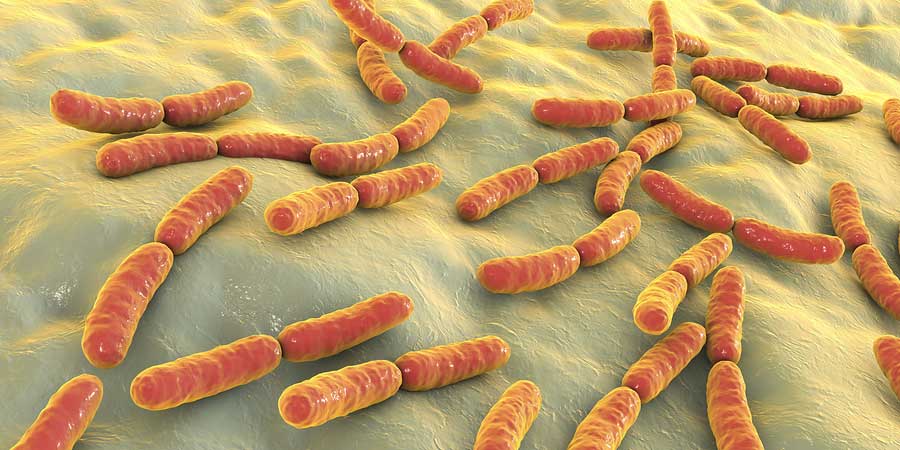This is part of our Ultimate Guide to Private Label Probiotics, a complete overview of the benefits of probiotic supplementation for consumers, some of the different strains and their specific uses, the process of responsibly manufacturing a probiotic product, and what to look for when choosing a probiotic manufacturer.
When probiotic cultures are listed on a product, such as a supplement or a food panel, they are typically listed with three separate descriptors in their name. These descriptors represent the genus, species, and strain of the culture. For example – on an average yogurt or dietary supplement container, the probiotic might be listed as such: “Lactobacillus acidophilus UALa-01™”.
“Lactobacillus” is the genus, “acidophilus” is the species and “UALa-01™” is the strain of bacteria.
Sometimes these names will be abbreviated on a label or food panel (as some of the names can be quite long). For example “Lactobacillus acidophilus” is sometimes written simply as “acidophilus”. Or, the genus Bifidobacteria or Lactobacillus might be abbreviated as B. or L. and combined with the individual strain name, such as acidophilus. (So this example would be listed as “L. acidophilus”.)
Different probiotics may have the same genus, but differences in the strain and species allow them to provide unique health benefits.
Classifying Probiotics

- Genus: A genus is a class of similar things, especially a group of animals or plants that includes several closely related species. In our example, the genus shares its name, “Lactobacillus”, with several other species, but their mutual traits are fairly general.
- Species: A species is a class of plants or animals whose members have the same main characteristics, and are able to breed with each other. In our example, the species shares its name, “acidophilus”, with several other strains, but they begin to vary much more. Different species of probiotics can have different abilities, and provide different health benefits.
- Strain: A strain of a germ, plant, or other organism is a particular type of it. In our example, the strain is “UALa-01™”, and is different from the others. Some strains are completely unique in their properties, offering benefits that no other strains do.
The two most common genera in probiotics are Lactobacillus and Bifidobacterium. Each of these families contains several different strains that are beneficial for your gut and overall health. It is the strains of these two main species which are the most commonly recognized, most commonly consumed, and also the most studied.
LACTOBACILLUS SPECIES

Currently, the genus Lactobacillus is made up of over 237 species (and 29 subspecies). This genus of bacteria contains strains that produce lactase, the enzyme that breaks down lactose, or milk sugar. These bacteria also work to produce lactic acid, which helps to control the population of bad bacteria, serves as muscle fuel, and increases the body’s absorption of minerals.† Following are some of the most important Lactobacillus strains, with some of their key benefits:
- Lactobacillus Acidophilus. In addition to playing an especially important role in maintaining good digestive health, L. acidophilus has been shown to benefit people with allergies and support the immune system against infection.†
- Lactobacillus Casei. L. casei helps to support, normal healthy cholesterol levels, and a properly functioning digestive system.† It also benefits people young and old when traveling or at home from diarrhea caused by bad bacteria either environmental or food-related.
- Lactobacillus Lactis. L. lactis, like its counterpart L. casei, offers many of the same benefits but it has also been studied for its positive effects against antibiotic-resistant pathogens and supporting healthy blood pressure.†
- Lactobacillus Paracasei. L. paracasei is often thought to be one of the most beneficial strains for aiding in digestive function. Research has also shown that L. paracasei supports the immune system in helping to fight infections and promote healing.†
- Lactobacillus Plantarum. L. plantarum is an exceptional strain, as it produces its own metabolites that are antibacterial. This helps the body to naturally target infection, helping to support overall immunity.†
- Lactobacillus Rhamnosus. This strain is particularly beneficial to women’s health, as it is not only beneficial in digestion, but also helps to nourish and support vaginal microflora to support urinary tract functions.†
- Lactobacillus Fermentum. In addition to helping to improve resistance and supporting the immune system, L. fermentum may also play an important role in supporting proper weight management through the gut-brain axis.†
- Lactobacillus Bulgaricus. This is one of the first probiotic strains ever studied. Some of the many researched benefits of L. bulgaricus include the ability to support normal, healthy cholesterol levels, nourish the intestinal tract, and maintain the integrity of the immune system.†
- Lactobacillus Gasseri. In addition to providing benefits associated with weight loss, inflammation, and cholesterol, L. gasseri provides several other potential benefits. It has been shown to support immunity in the elderly, and nourish the respiratory system for those with allergies.†
- Lactobacillus Reuteri. Like most probiotics, L. reuteri is important in intestinal and digestive health. Interestingly, a strain of Lactobacillus reuteri has been found to support the production of hormones such as testosterone and oxytocin levels of testosterone and oxytocin in animal studies.†
BIFIDOBACTERIUM SPECIES

Currently, the genus Bifidobacterium is made up of over 80 subspecies. They are among the first microbes to colonize the human gastrointestinal tract (appearing within days of birth, especially in breastfed infants), and make up most of the healthy bacteria in the colon. Bifidobacterium species are thought to support the immune system, and to limit the growth of harmful bacteria in the intestine.† Following are some of the most important Bifidobacterium strains, with some of their key benefits:
- Bifidobacterium Bifidum. The strain B. Bifidum was first identified over 60 years ago., in infant intestines. Occurring naturally in the bodies of all humans, factors such as diet, stress, infection, antibiotics can deplete their numbers. Several high-quality studies on B. bifidum have shown promise in instances irritable bowel syndrome (IBS) by supporting immune response.†
- Bifidobacterium Breve. B. breve is one of the most helpful probiotic bacteria in the human body. It is unique in its ability to compete with other harmful bacteria due to the large variety of molecules that it can digest. This powerhouse strain helps to support regularity and digestion.†
- Bifidobacterium Lactis. This strain is one of the most versatile and hardest working, as it supports normal healthy cholesterol levels, and supports the integrity of the intestinal tract which is key to preventing colitis and other diseases of improper nourishment.†
- Bifidobacterium Longum. Unlike some probiotics, B. longum isn’t affected by stomach acid, bile, pH fluctuations, or the passage through the gastrointestinal tract. B. Longum benefits the body by helping to ease common, occasional gastrointestinal discomfort caused by chronic stress and anxiety.
- Bifidobacterium Infantis. This strain of probiotic can fight against the harmful bacteria in foods and is beneficial to supporting regularity, calcium absorption, and proper kidney function.†
OTHER SPECIES

STREPTOCOCCUS SPECIES
We mostly are familiar with the word “Streptococcus” when thinking of Strep Throat. In reality, Streptococcus is yet another beneficial species of probiotics.
- Streptococcus Thermophilus. S. thermophilus is a powerful probiotic strain that has well-researched health benefits associated with immunity and digestion. This strain also produces lactase, which can aid in the digestion of dairy for those with a sensitivity to lactose.
YEAST
The word “yeast” may often carry negative associations when considering the body. There is one type of yeast, however, that actually functions like a probiotic.
- Saccharomyces Boulardii. S. boulardii has been recommended by doctors for decades to provide aid with many types of diarrhea. It has also been shown to help protect the intestines from pathogens, gastrointestinal diseases, and other things that can damage the intestinal lining, and to help modulate different parts of the immune system.†
There are many other genera, species, and strains of probiotics. The several mentioned here are the ones most commonly seen in foods and supplements. Although research is ongoing, it is clear that probiotics can provide various health benefits. Taking the right type of probiotics may help in targeting specific health issues and improving overall health.
Key Takeaways
- Probiotics are classified according to Genus, Species, and Strain.
- Different probiotics may have the same genus, but differences in the strain and species allow them to provide unique health benefits.
- The two most common genera in probiotics are Lactobacillus and Bifidobacterium. Each of these families contains several different strains that are beneficial for your gut and overall health.
Next: ➤ Learn More About the Importance of Prebiotics in Private Label Probiotic Supplements.

†These statements have not been evaluated by The Food and Drug Administration. This product is not intended to diagnose, treat, cure or prevent any disease.





